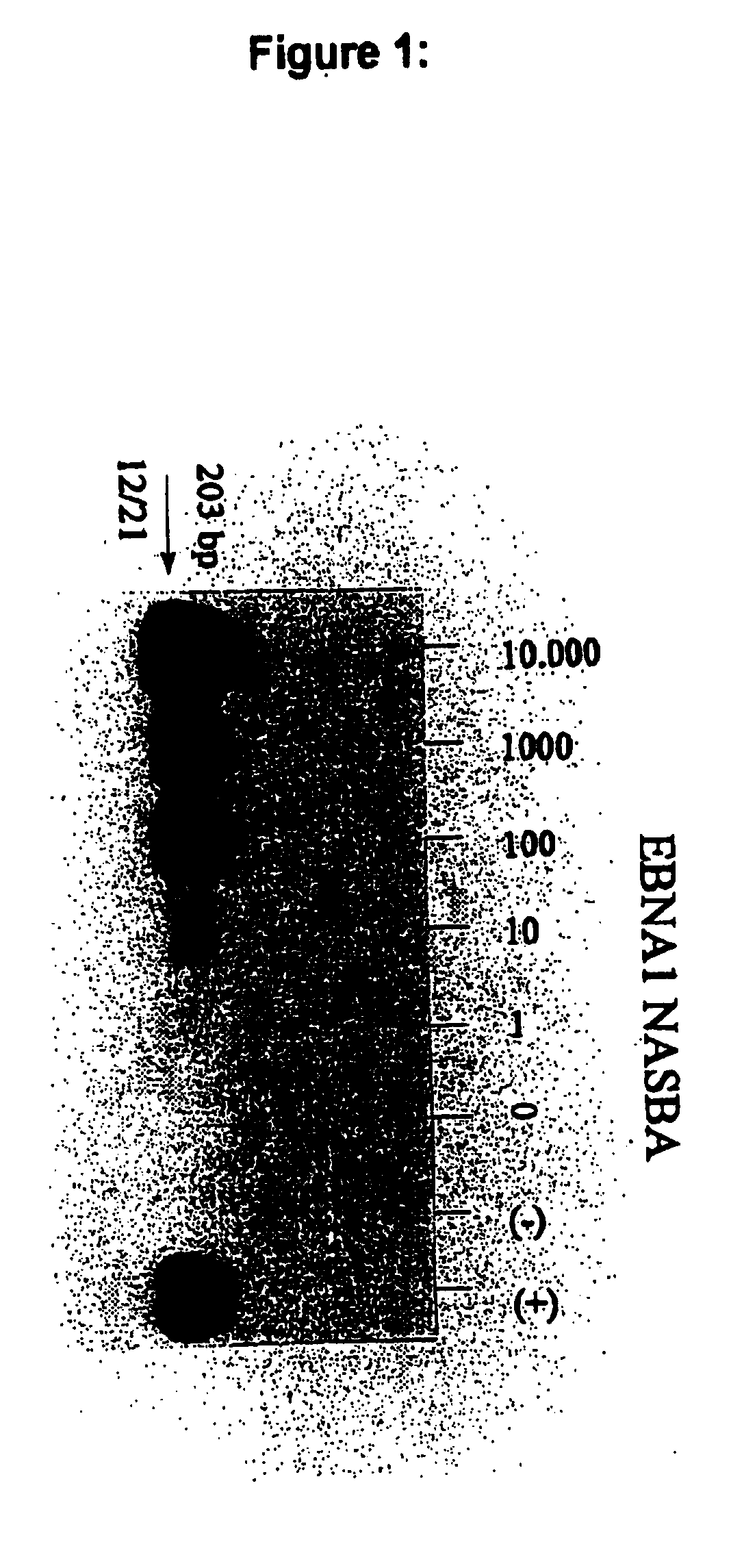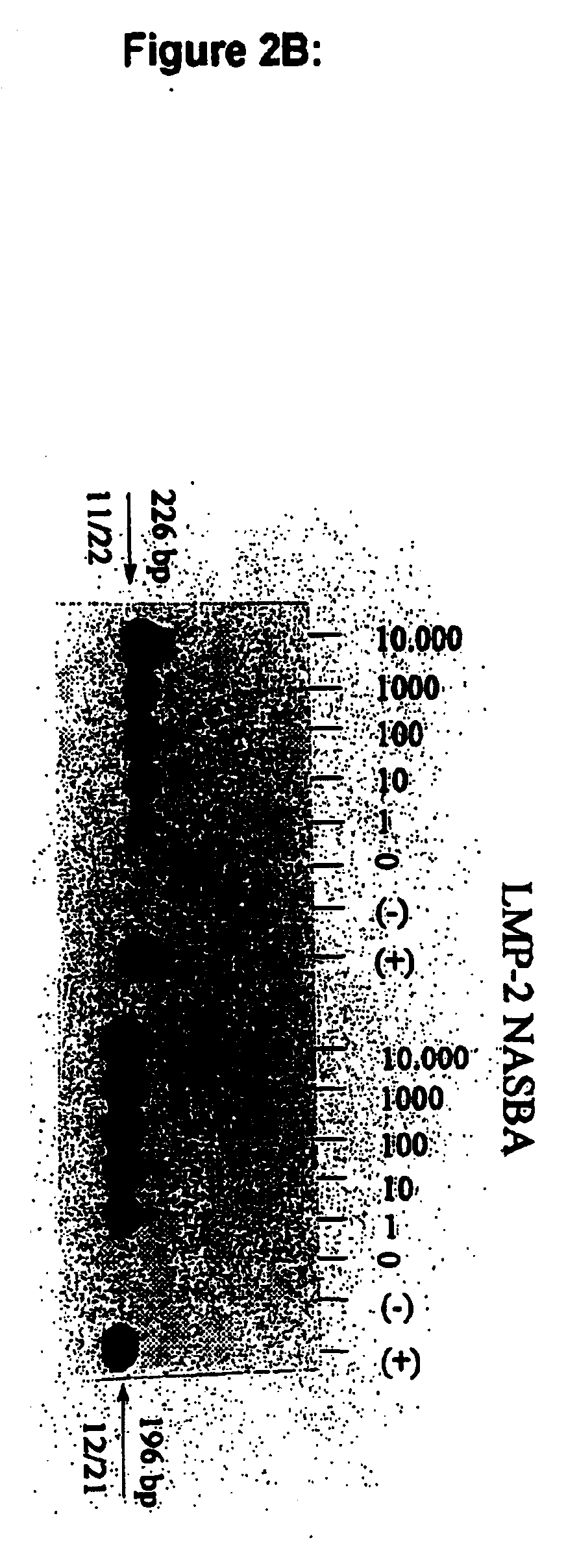Oligonucleotides for the amplification and detection of epstein barr virus (EBV) nucleic acid
a technology of oligonucleotides and epstein barr virus, which is applied in the field of oligonucleotides for the amplification and detection of epstein barr virus (ebv) nucleic acid, can solve the problems of lymphoproliferative disease, full-blown malignancy, and detection of epithelial replication of the virus
- Summary
- Abstract
- Description
- Claims
- Application Information
AI Technical Summary
Benefits of technology
Problems solved by technology
Method used
Image
Examples
example 1
[0063] Selection and Optimization of Specific Primer and Probe Sequences for the Detection of EBNA-1 mRNA.
[0064] From a large panel of in vitro cultured BL and LCL cell lines obtained from different parts of the world and from fresh tumor biopsy specimens from a variety of EBV positive tumor tissues, the specific nucleotide sequence of the BKRF1 reading frame was determined and aligned with the prototype B95-8 sequence. Surprisingly, it became apparent from these data that the field isolates of EBV were rather more conserved when aligned with each other than when compared to the B95-8 sequence, making the latter rather a mutant strain. In addition, certain mutations were observed that were more common among NPC- and LCL's derived sequences obtained from SE-Asia, whereas other mutations were more common among LCL and BL-derived isolates from central Africa, indicative of regional strain differences, in the different LCL's analysed, B95-8 transformed lines could be clearly discriminat...
example 2
[0071] Detection of Additional EBV RNA Targets Using Optimized Primer Sets.
[0072] Similarly, sequence comparison and primer optimization studies allowed the selection of specific sets of reagents for the detection of EBV-encoded mRNA for LMP-1, LMP-2, EBER-1 and other EBV gene targets. For some targets the results are shown in FIG. 2, panels A-D.
[0073] FIG. 2 panels A and B shows the results of NASBA reactions for LMP-1 and LMP-2 on dilution series of EBV-positive JY cells in 50,000 EBV-negative RAMOS cells as described for EBNA1.
[0074] The data indicate that LMP-1 specific primerset 1.1 (SEQ.ID.No.: 12) combined with 2.1 (SEQ.ID.No.: 14), giving a product of 248 bp, allows the detection of mRNA equivalent to 1-10 JY cells in a background of 50,000 EBV-negative RAMOS cells. The LMP-2 set 1.2 (SEQ.ID.No.: 18) combined with 2.1 (SEQ.ID.No.: 19), giving a product of 196 bp, allows the dear detection of 1 JY cell in the presence of 50,000 RAMOS cells, which is slightly better than the c...
example 3
[0077] Optimization of EBV-RNA Isolation and NASBA Reaction Conditions.
[0078] Optimization of RNA isolation method or NASBA reaction conditions, such as concentration of DMSO, KCl or Betaine (N,N,N-trimethylglycine) may improve the sensitivity of detection of EBV-specific RMA without affecting its specificity.
[0079] FIG. 3A shows the comparison of two RNA isolation methods for the isolation of the small molecular weight EBER1 RNA's, which are present at high abundance in EBV-transformed cells like JY, but which are not isolated with high efficiency by the silica method of Boom et al. Standardized quantities of in vitro generated 170 bp runoff transcripts were used as input for RNA isolation using the RNAzol (Cinna Biotex) and Boom isolation methods. Isolated RNA was used as input for NASBA with primers 1.1 (SEQ.ID.No.: 6) and 2.2 (SEQ.ID.No.: 7) giving a product of 140 bp. The results show that the RNAzol method results in a 10-100 fold more efficient extraction level of this small ...
PUM
| Property | Measurement | Unit |
|---|---|---|
| Length | aaaaa | aaaaa |
Abstract
Description
Claims
Application Information
 Login to View More
Login to View More - R&D
- Intellectual Property
- Life Sciences
- Materials
- Tech Scout
- Unparalleled Data Quality
- Higher Quality Content
- 60% Fewer Hallucinations
Browse by: Latest US Patents, China's latest patents, Technical Efficacy Thesaurus, Application Domain, Technology Topic, Popular Technical Reports.
© 2025 PatSnap. All rights reserved.Legal|Privacy policy|Modern Slavery Act Transparency Statement|Sitemap|About US| Contact US: help@patsnap.com



